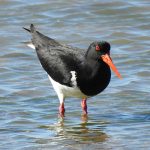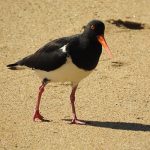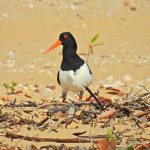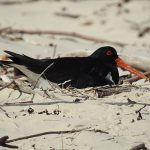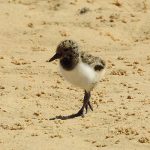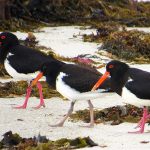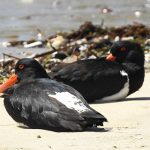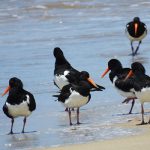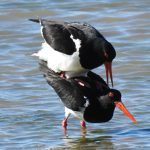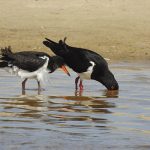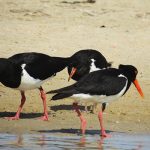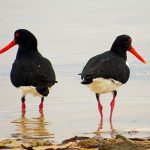PIED OYSTERCATCHER
The Pied Oystercatcher (Haematopus longirostris)
The Pied Oystercatcher is one of Australia’s most striking coastal birds, instantly recognisable with its bold black-and-white plumage and long, bright orange-red bill. Despite its name, this bird rarely eats oysters—instead, it uses its powerful bill to prise open bivalves and probe for soft-bodied invertebrates along sandy and rocky shores.
Appearance
- Plumage: Glossy black head, neck, wings, and back contrasted with a white belly and rump.
- Bill: Long, straight, and vividly orange-red, perfectly adapted for foraging.
- Eyes: Bright red with a fine orange orbital ring.
- Legs: Pinkish-red, sturdy for wading in shallow waters.
- Size: Around 48 cm in length, with a wingspan of 80–90 cm.
The bird’s dramatic colouring gives it an almost formal appearance, like a creature dressed in a tuxedo, standing out starkly against pale sand or wet mudflats.
Habitat and Distribution
The Pied Oystercatcher is found along almost the entire Australian coastline, avoiding only the most heavily urbanised or disturbed beaches. They favour:
- Sandy beaches
- Mudflats and estuaries
- Rocky shorelines
- Coastal lagoons
They are rarely seen inland, as they are highly specialised shorebirds.
Diet and Feeding
Despite its name, the Pied Oystercatcher does not primarily consume oysters. Instead, it forages for:
- Mussels
- Cockles
- Pipis (a type of small clam common on sandy beaches)
- Crabs and marine worms
Its strong bill acts like a chisel, either stabbing into shells or levering them open. On beaches, it can often be seen probing the sand with quick, precise movements.
Behaviour and Breeding
- Territorial: Strongly defends feeding and nesting territories, especially during the breeding season.
- Breeding Season: Usually between July and January.
- Nesting: A simple scrape in the sand, often just above the high tide line. Eggs are pale and speckled, blending perfectly with the beach substrate.
- Chicks: Downy and well-camouflaged, but highly vulnerable to predators and human disturbance.
Parents are attentive and can be seen performing distraction displays—limping or pretending to be injured—to lure predators away from their chicks.
Conservation Status
The Pied Oystercatcher is not classified as globally threatened, but in Australia it faces localised declines due to:
- Human disturbance of nesting beaches
- Predation by introduced species (foxes, cats, dogs)
- Habitat loss from coastal development
- Vehicles driving on beaches, which can crush eggs or chicks
Because they nest directly on the sand, they are especially vulnerable to human recreation along popular coastlines.
Interesting Facts
- Name Misleading: Despite being called an “oystercatcher”, oysters are rarely eaten. They prefer softer-shelled molluscs.
- Long Lifespan: They can live more than 25 years in the wild.
- Lifelong Partners: Pairs often bond for life, returning to the same nesting territory year after year.
- Distinctive Calls: Their loud piping calls carry across beaches, especially during territorial disputes.
- Important Indicator Species: Because they rely on healthy coastal ecosystems, their presence and breeding success can be a measure of environmental health.
Subtle Conservation Message
The Pied Oystercatcher is a reminder of how delicate the balance is between human recreation and wildlife survival. Something as simple as keeping dogs on leads at the beach, avoiding driving on sand dunes, or respecting nesting signs can greatly improve their chances of successfully raising young.
By protecting these birds, we also preserve the integrity of Australia’s coastal ecosystems—ensuring that shorelines remain alive with the calls and footprints of wildlife.

